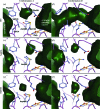A hydrogen-bonding network is important for oxidation and isomerization in the reaction catalyzed by cholesterol oxidase
- PMID: 19923719
- PMCID: PMC3089011
- DOI: 10.1107/S0907444909037421
A hydrogen-bonding network is important for oxidation and isomerization in the reaction catalyzed by cholesterol oxidase
Abstract
Cholesterol oxidase is a flavoenzyme that catalyzes the oxidation and isomerization of 3beta-hydroxysteroids. Structural and mutagenesis studies have shown that Asn485 plays a key role in substrate oxidation. The side chain makes an NH...pi interaction with the reduced form of the flavin cofactor. A N485D mutant was constructed to further test the role of the amide group in catalysis. The mutation resulted in a 1800-fold drop in the overall k(cat). Atomic resolution structures were determined for both the N485L and N485D mutants. The structure of the N485D mutant enzyme (at 1.0 A resolution) reveals significant perturbations in the active site. As predicted, Asp485 is oriented away from the flavin moiety, such that any stabilizing interaction with the reduced flavin is abolished. Met122 and Glu361 form unusual hydrogen bonds to the functional group of Asp485 and are displaced from the positions they occupy in the wild-type active site. The overall effect is to disrupt the stabilization of the reduced FAD cofactor during catalysis. Furthermore, a narrow transient channel that is shown to form when the wild-type Asn485 forms the NH...pi interaction with FAD and that has been proposed to function as an access route of molecular oxygen, is not observed in either of the mutant structures, suggesting that the dynamics of the active site are altered.
Figures





Similar articles
-
The presence of a hydrogen bond between asparagine 485 and the pi system of FAD modulates the redox potential in the reaction catalyzed by cholesterol oxidase.Biochemistry. 2001 Nov 20;40(46):13779-87. doi: 10.1021/bi010843i. Biochemistry. 2001. PMID: 11705367
-
Evaluation of the role of His447 in the reaction catalyzed by cholesterol oxidase.Biochemistry. 1998 Dec 22;37(51):17990-8000. doi: 10.1021/bi982115+. Biochemistry. 1998. PMID: 9922167
-
The binding and release of oxygen and hydrogen peroxide are directed by a hydrophobic tunnel in cholesterol oxidase.Biochemistry. 2008 May 13;47(19):5368-77. doi: 10.1021/bi800228w. Epub 2008 Apr 15. Biochemistry. 2008. PMID: 18410129 Free PMC article.
-
Dissection of a flavoenzyme active site: the reaction catalyzed by cholesterol oxidase.Antioxid Redox Signal. 2001 Oct;3(5):839-46. doi: 10.1089/15230860152665019. Antioxid Redox Signal. 2001. PMID: 11761331 Review.
-
Cholesterol oxidase: structure and function.Subcell Biochem. 2010;51:137-58. doi: 10.1007/978-90-481-8622-8_5. Subcell Biochem. 2010. PMID: 20213543 Review.
Cited by
-
Use of an Isotope-Coded Mass Tag (ICMT) Method To Determine the Orientation of Cholesterol Oxidase on Model Membranes.Biochemistry. 2018 Sep 11;57(36):5370-5378. doi: 10.1021/acs.biochem.8b00788. Epub 2018 Aug 28. Biochemistry. 2018. PMID: 30125103 Free PMC article.
-
Cloning, expression and biochemical characterization of the cholesterol oxidase CgChoA from Chryseobacterium gleum.BMC Biotechnol. 2014 May 21;14:46. doi: 10.1186/1472-6750-14-46. BMC Biotechnol. 2014. PMID: 24885249 Free PMC article.
-
Crystallization and preliminary X-ray analysis of pyridoxine 4-oxidase, the first enzyme in pyridoxine degradation pathway I.Acta Crystallogr Sect F Struct Biol Cryst Commun. 2012 Jan 1;68(Pt 1):66-8. doi: 10.1107/S1744309111048688. Epub 2011 Dec 24. Acta Crystallogr Sect F Struct Biol Cryst Commun. 2012. PMID: 22232175 Free PMC article.
References
-
- Christopher, J. A. (1998). The SPOCK Program Manual. http://quorum.tamu.edu/Manual/Manual/Manual.html.
-
- Collaborative Computational Project, Number 4 (1994). Acta Cryst. D50, 760–763. - PubMed
-
- DeLano, W. L. (2002). The PyMOL Molecular Graphics System. DeLano Scientific, San Carlos, California, USA.
MeSH terms
Substances
Grants and funding
LinkOut - more resources
Full Text Sources
Research Materials
Miscellaneous

